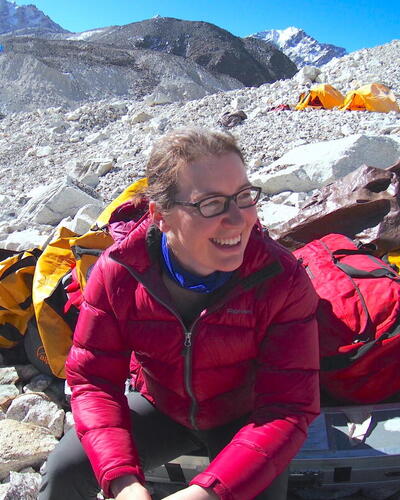Mountain glaciers
Glaciers form an important water supply in mountain ranges such as the Himalaya and the Andes, and are sensitive indicators of palaeoclimate change.

Main content
Mountain glaciers respond rapidly to climate change and are a major contributor to the hydrological budgets of regions that are vulnerable to the impacts of a changing climate, in particular, High Mountain Asia and South America. Understanding how these glaciers have changed during the Holocene and will continue to change with anthropogenic warming is valuable for both reconstructing palaeoclimate through periods of rapid global change and for mitigating the effects of future climate change.
Research under this theme investigates the dynamic behaviour of mountain glaciers, focussing on debris-covered glaciers and rock glaciers which are challenging to interpret. We use a combination of glaciological monitoring techniques including close-range remote sensing, photogrammetry and hot-water drilling, combined with computer modelling to understand the processes that affect the behaviour of mountain glaciers. To interpret glacier change over longer timescales and through major climatic events such as the Last Glacial Maximum, we include geomorphological and geochronological observations of glacial landscapes.
Glacier behaviour in response to Holocene and anthropogenic climate change
We collect data from the surfaces and interiors of glaciers to characterise processes that are important for mass balance and ice flow. These data are used to constrain and evaluate numerical models of glacier evolution over decadal to centennial timescales. Observations of glacial geomorphology are also needed to infer glacier change over longer timescales and allow numerical models to reconstruct glacier behaviour since the LGM and project possible future changes through the 21st and 22nd Centuries.
Automated mapping and characterisation of glacial and peri-glacial environments
Remote sensing data, such as satellite imagery and aerial photography, can be a useful tool for mapping glacial and periglacial landforms over large areas. While clean glacier ice is relatively easy to map due to its distinct spectral signature, debris-covered glaciers and rock glaciers are spectrally indistinct from the surrounding terrain. Therefore, we use a variety of advanced remote sensing (for example radar interferometry and Object-Based Image Analysis) and machine learning techniques (random forest classifiers as well as convolutional-neural networks) to identify these landforms accurately and automatically.
Assessing glacial and periglacial changes using remote sensing data
We are using a combination of aerial photography, satellite imagery, UAVs, and LiDAR data to quantify how the mountain cryosphere is changing over time. By utilising archived datasets such as historical aerial photography, or declassifed spy satellite imagery, it is possible to quantify glacier changes back to the 1950s or in some cases, even earlier. Short-range remote sensing such as terrestrial laser scanners and UAVs can help shed light on small-scale processes such as supraglacial lake formation and the influence of supraglacial debris on glacier mass balance.







